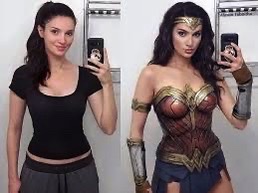Image Attribution: “Wonder Woman Cosplay – Brianna Kreil” by Alyson Tabbitha is licensed under CC0. (See interactive map)
In the photograph above we see Alyson Tabbitha, a well-known cosplay impersonator dressed as the one and only Wonder Woman. In the photo on the left, we see Tabbitha in her casual day-to-day attire but when we look at the photo on the right we see her transformation. This photo was originally taken on October 7th, 2017 but has been resurfacing the internet every year around Halloween. This specific photo was not used for a cosplay event however Tabbitha has worn this costume to many cosplay events including, Holiday Matsuri, Megacon, Orlando Centre, and many more. Tabbitha has also done charity events and many paid ads for dc comics in her Wonder Woman costume. Tabitha’s costume is fully handmade, the armor was made out of craft foam and poster board while the breastplate was out of treeflx. Tabitha also hand-crafted the belt, shoes, lasso, and other props (not shown in the photo). Tabbitha portrays Wonder Woman exceptionally well due to her hair color and length, physical physique, and a nearly identical replica of the costume. Wonder Woman is a superhero from the DC Universe who is also a princess who received her powers from the Greek gods.
People dress up as Wonder Woman because she “is a feminist icon, for her devotion to truth, justice, and equality. many cosplayers identified with Wonder Woman both in their own personalities and as a feminist icon, and many view Wonder Woman as a larger role model to all people, not just women and girls (Grissom A 2019. “The Wonder Women: Understanding Feminism in Cosplay Performance”). When looking into cosplay, “we should realize that cosplayers use their bodies explicitly to display their affection for certain narratives. At some conventions, wearing a costume is becoming implicitly expected. Fans in street clothes stand out at conventions where most attendees are in costume. Nonetheless, the difference between those who are dressed up and those who are not is not as clear as it might seem.” (Lamerichs N 2011. “Stranger than Fiction: Fan Identity in Cosplay.”) “In analyzing the identity of the cosplaying fan, we must take into account both appearance and behavior. Cosplayers are usually judged according to body features, behavior, and design. However, the characters they portray are strongly embedded in a medium whose design may make doing justice to their appearance impossible; the majority of the costumes fans wear are self-made.” (Lamerichs N 2011. “Stranger than Fiction: Fan Identity in Cosplay.”)
References:
“Theory.” Transformative Works and Cultures, https://journal.transformativeworks.org/index.php/twc/article/download/246/230?inline=1.
https://journal.transformativeworks.org/index.php/twc/article/download/246/230?inline=1
Grissom, Amber. “The Wonder Women: Understanding Feminism in Cosplay Performance.” STARS, https://stars.library.ucf.edu/etd/6493/.
https://stars.library.ucf.edu/etd/6493/
